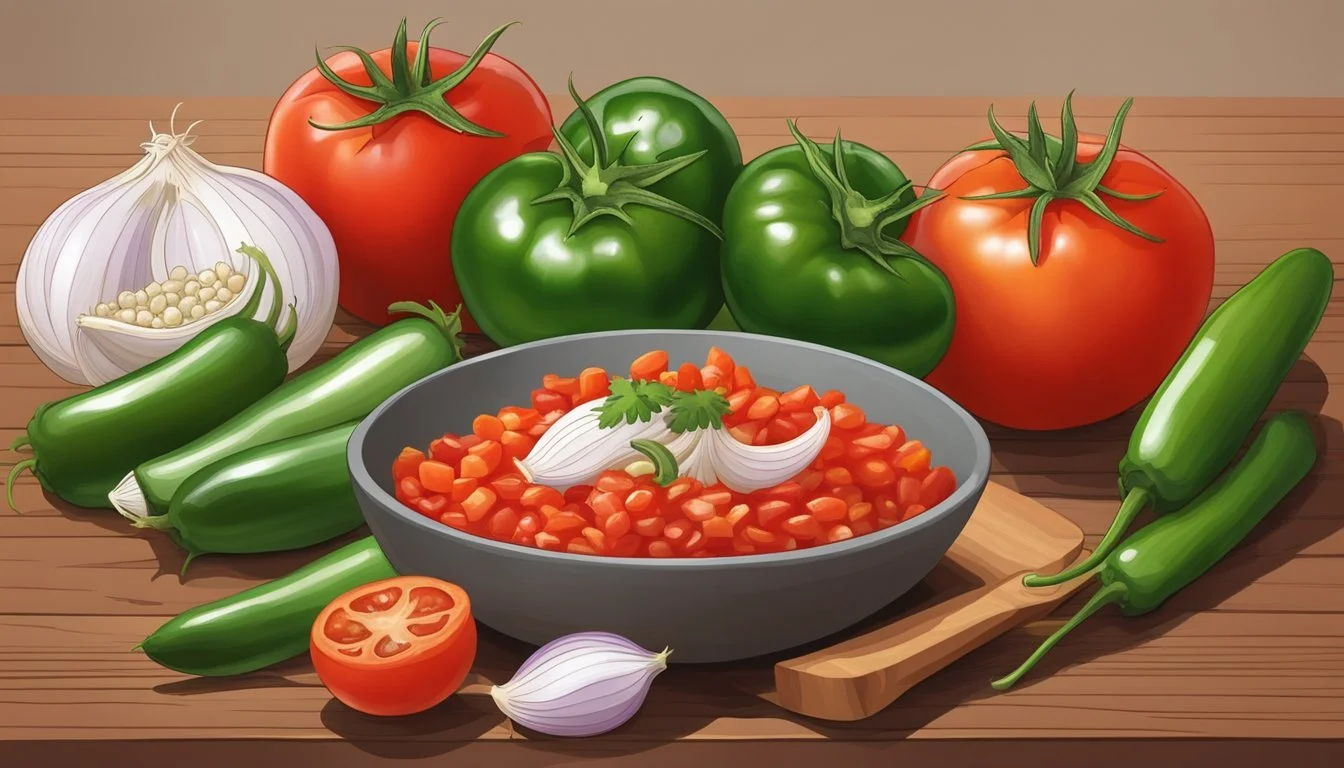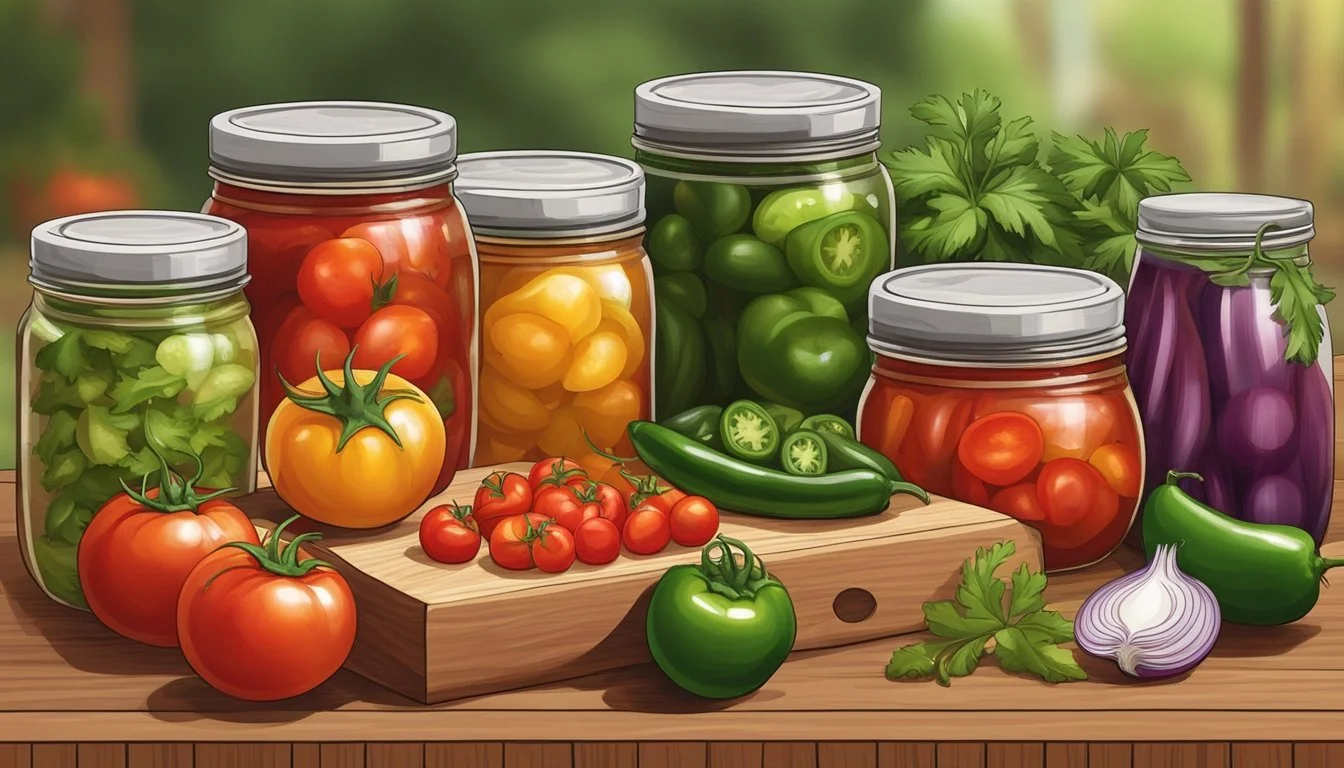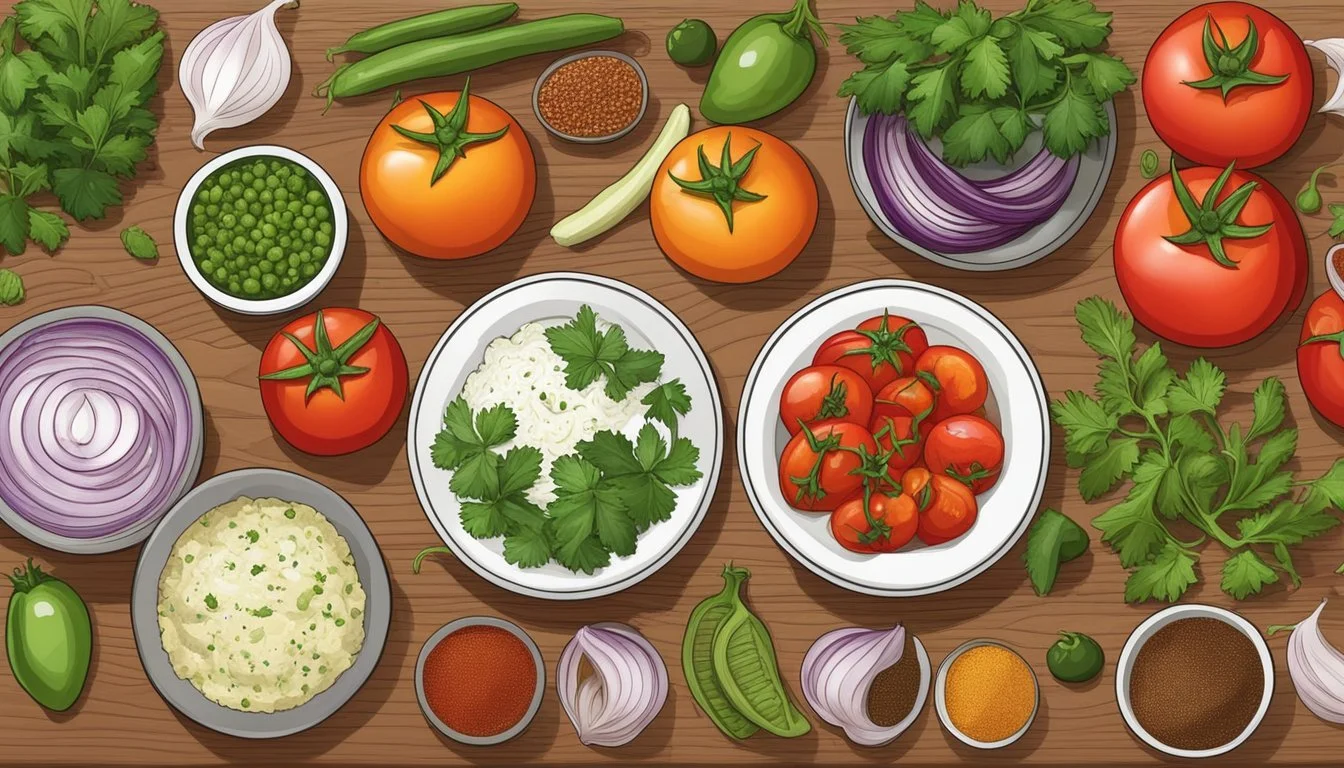Pantry-Friendly Homemade Salsa Recipes
Quick and Easy Variations
Salsa is a versatile condiment that can enhance the flavor of numerous dishes, from simple nachos to gourmet entrees. While many may associate salsa with fresh ingredients and summertime, it's also possible to create delicious versions using pantry staples. Pantry-friendly homemade salsa recipes are perfect for those times when fresh produce is not readily available, or when convenience and speed are of the essence.
Creating a flavorful homemade salsa does not necessarily require fresh tomatoes or exotic ingredients. Canned tomatoes, for instance, can serve as a reliable base for a tasty salsa, proving that accessibility and ease do not have to compromise taste. With the addition of spices, canned chiles, and a splash of acidity from vinegar or lime juice, these pantry salsas provide a quick solution for a flavorful dip or a zesty topping for various dishes.
The Fundamentals of Homemade Salsa
Creating a delightful homemade salsa balances fresh taste with nutritional advantages, incorporating both fresh produce and pantry staples. This balance ensures a flavorful and healthy addition to various dishes.
Essential Ingredients
Tomatoes: A cornerstone of salsa, tomatoes provide a rich, acidic base. They can be fresh or canned for pantry-friendly recipes.
Peppers: Depending on the desired heat level, one can use jalapeños, serranos, or bell peppers for a milder taste.
Onion: White or red onions add a pungent, crisp texture.
Cilantro: This herb infuses fresh salsa with its distinct bright flavor.
Lime Juice: Fresh lime juice is preferred for its zest and helps balance the flavors.
Salt: A pinch of salt enhances the overall taste profile of salsa.
Consider combining these ingredients in different proportions to adjust to personal preferences.
Salsa Varieties
Classic Fresh Salsa: Combines finely chopped fresh tomatoes, onions, cilantro, peppers, lime juice, and salt.
Pantry Salsa: Utilizes canned tomatoes and may include a mixture of pantry spices for ease and convenience.
Nutritional Note: Homemade salsa can be a low-calorie, nutritious option, adding significant flavor with few additional calories.
Experimentation with different ingredients like fruits or other spices can yield a wide range of salsa varieties to enjoy.
Pantry-Friendly Salsa Recipes
These recipes enable one to create sumptuous salsa right at home using ingredients commonly found in the pantry. They are perfect for a quick snack with tortilla chips, as a condiment in various dishes, or even to make ahead for future gatherings.
Classic Tomato Salsa Recipe
For a traditional salsa, canned tomatoes serve as the convenient backbone, augmented by the brightness of lime juice for acidity. A pinch of cumin and oregano add a warm and earthy aroma, while garlic powder brings pungent depth. The classic tomato salsa balances fresh flavors and spices, making it a staple snack with tortilla chips.
Ingredients:
Canned tomatoes: 1 (15-oz) can
Lime: Juice of 1 lime
Cumin: 1/4 tsp
Oregano: 1/4 tsp
Garlic powder: 1/4 tsp
Fresh cilantro: To taste, chopped
Spicy Salsa Verde Recipe
To turn up the heat, the salsa verde features fire roasted green chilis or jalapenos, which provide a smoky and spicy profile. This salsa verde combines the bold flavors of roasted peppers with the zesty kick of lime, perfect for those who enjoy a bit of heat.
Ingredients:
Fire roasted green chilis: 1 (4-oz) can
Lime: Juice of 1 lime
Garlic: 2 cloves, minced
Sweet and Savory Mango Salsa Recipe
For a fruity twist, the mango salsa recipe brings in a sweet component that pairs magnificently with savory dishes. Fresh cilantro offers an herbaceous note, contrasting the sweetness of mango, which makes this delicious salsa a unique and delightful accompaniment.
Ingredients:
Mango: 1 large, diced
Canned tomatoes: 1/2 cup
Lime: Juice of 1 lime
Fresh cilantro: To taste, chopped
Each of these homemade salsa recipes utilizes accessible pantry staples and fresh produce to create flavorful dips and toppings that are ready to be enjoyed in minutes.
Specialty Salsa Creations
In any well-stocked pantry, the inclusion of salsas that combine classic ingredients with inventive twists can elevate simple dishes to extraordinary culinary experiences. They offer a versatile range of flavors from the smokiness of black beans to the unexpected sweetness of strawberries, rounded off with the richness of avocado.
Black Bean and Corn Salsa Recipe
Black Bean and Corn Salsa offers a hearty texture that makes for a perfect companion to grilled chicken tacos or as a standalone dip for tortilla chips. The combination of black beans for protein and fiber, with sweet corn for a juicy crunch, creates a satisfying mix. For brightness, add diced red onions and jalapeños. A splash of oil and a squeeze of lime juice bring the flavors together.
Unique Strawberry Salsa Recipe
A playful twist on the salsa theme, Strawberry Salsa combines ripe strawberries with jalapeño peppers, delivering a balance of sweet and spicy that can surprise and delight a crowd. It pairs exceptionally well with crispy fish tacos or as a vibrant addition to queso. The key is to use fresh strawberries for a bright and vivid flavor profile.
Rich Avocado Salsa Verde Recipe
For those who prefer a creamier texture, Avocado Salsa Verde is a must-try. Blending ripe avocados with a tangy salsa verde base, typically made from "Muir Glen" tomatillos, one can achieve a smooth and indulgent dip. Incorporate finely chopped white onion, cilantro, and jalapeño for a complex flavor. It's a rich condiment that can turn a simple burrito into a gourmet treat or act as a twist on traditional guacamole for any gathering.
Serving and Pairing Salsa
A well-crafted homemade salsa serves as both a flavor enhancer and a standalone dish. Its versatility allows it to complement a plethora of meals or act as a delicious side snack for a gathering.
Pairings for Meals
Salsa, with its vibrant flavor profile, is commonly paired with traditional Mexican dishes. Homemade salsa verde, a tangy blend of tomatillos and jalapeño, is an excellent addition to tacos and quesadillas. Its vivid, tangy flavor can also elevate a simple Mexican chicken dish. Huevos rancheros, a hearty egg-based meal, receives a fresh twist with salsa, as do breakfast items like breakfast burritos. Likewise, a restaurant-style salsa, typically made in a food processor or blender, pairs well with main courses lending a crowd-pleasing zing with minimal effort.
Tacos: A spoonful of salsa adds heat and complexity.
Quesadillas: Salsa inside or on top introduces a refreshing contrast.
Mexican Chicken: Salsa acts as a zesty sauce or marinade.
Breakfast Burritos/Huevos Rancheros: For a morning kick, salsa provides a bold flavor.
Salsa as a Side Snack
As a side snack, salsa most often teams up with tortilla chips as a classic dip, perfect for any social event. For an additional layer of taste, a dollop of sour cream can be added alongside the salsa. Alternatively, presenting a homemade salsa alongside nachos laden with cheese and jalapeños creates a hearty and healthy snack option. Lime, a frequent salsa ingredient, gives a refreshing zest that makes it irresistible for snacking.
Tortilla Chips: Salsa's best friend, providing a satisfying crunch.
Nachos: Layer with cheese, jalapeños, and salsa for a fulfilling treat.
Sour Cream: Offers a creamy balance to salsa's acidity.
Advanced Salsa Tips and Techniques
When crafting homemade salsa, utilizing the right techniques can significantly elevate both texture and flavor. The following strategies guide enthusiasts on how to refine their salsa to professional standards.
Achieving the Perfect Texture
The texture of salsa is paramount; it's the tactile dance that accompanies every bite. To ensure consistency, here are two critical elements to consider:
Pulse Precision: Whether using a blender, food processor, or immersion blender, the key to texture is pulsing. Short, controlled pulses allow an individual to achieve anything from a rustic, chunky salsa to a smooth, restaurant-style dip. For a crunchy texture, opt for hand-chopping ingredients and a brief mix to retain that fresh, crisp characteristic.
Ingredient Order: Some ingredients blend better when added at different stages. Begin with firmer ingredients like onions and peppers, then add softer items like tomatoes. This tiered approach preserves the desired texture throughout the salsa.
Flavor Enhancements
Salsa is not just about heat; it's about building a complex layer of flavor. Here are some techniques to augment the depth and richness of salsa:
Spices and Herbs: Introduce a touch of smokiness with a hint of adobo sauce or a dash of cumin. Oregano offers earthy notes, while garlic powder can amplify the savory elements—all without overwhelming the fresh ingredients.
Chili Choices: The variety of chili peppers can drastically alter the flavor profile. For a nuanced heat that won't overpower, remove seeds and ribs from peppers like jalapeños. To increase intensity, experiment with a finely chopped habanero.
By adhering to these advanced tips and techniques, one can create a salsa that not only complements their pantry items but also stands as a testament to their culinary prowess.
Nutrition and Health Benefits
Homemade salsa can be a nutritious addition to one's diet. It often incorporates a variety of fresh ingredients, such as tomatoes, onions, and peppers, which are loaded with vitamins and minerals. Tomatoes, for example, are high in vitamin C and lycopene, an antioxidant that has been linked to numerous health benefits.
High fiber content is another hallmark of salsa, specifically when it includes ingredients like black beans or corn. Fiber is essential for digestive health and can aid in regulating blood sugar levels.
Salsa's healthfulness is further enhanced when it's prepared at home, as it allows for control over the amount of salt, avoiding the excessive sodium that's typical in many store-bought versions. A low-sodium salsa can be especially beneficial for individuals monitoring their blood pressure.
Nutrient Benefits Vitamin C Antioxidant, immune support Lycopene May lower cancer risk Dietary Fiber Aids digestion, controls blood sugar
In addition to being packed with essential nutrients, homemade salsa is generally low in calories, making it a healthy choice for individuals seeking to maintain or lose weight.
Overall, homemade salsa offers a combination of beneficial nutrients without the preservatives and additives found in many processed foods. When enjoyed as part of a balanced diet, salsa can contribute to an individual's overall nutrient intake while also adding vibrant flavor to meals.
Salsa Preservation and Storage
When making homemade salsa, especially with pantry-friendly ingredients, understanding proper storage techniques ensures both freshness and flavor. One can use fresh ingredients to make a best red salsa that remains vibrant for days or can be frozen for longer enjoyment.
Short-Term Storage Solutions
For short-term storage of homemade salsa, which might feature lime juice, salt and pepper, and even fire-roasted tomatoes for a rich flavor, the following steps are recommended:
Refrigeration: Salsa should be stored in an airtight container in the refrigerator.
Duration: Fresh salsa typically lasts between 5 to 7 days when refrigerated.
Tips for Freezing Salsa
For those who prefer to make ahead and enjoy their salsa over an extended period, freezing is an optimal choice, and it applies even to mild salsa varieties or those enriched with a zesty hint of fresh lime. Use these guidelines:
Freezing Method:
Pour the salsa into a freezer bag or an airtight container, leaving some space to allow for expansion as it freezes.
Label the bag with the date to keep track of how long it has been stored.
Duration: Salsa can be frozen for up to 2 months for optimal flavor quality.
It is important to note that due to the texture changes caused by freezing and thawing, the salsa might have a more watery consistency but will still be flavorful and freezer-friendly for versatile use.
Beyond The Bowl: Creative Uses for Salsa
Salsa's versatility extends far beyond a simple dip for tortilla chips. It can enhance the flavor profile of numerous main courses and appetizers (What wine goes well with appetizers?), often adding a vibrant, fresh element to every bite.
Salsa-Infused Main Courses
Salsa can transform a main dish with a burst of flavor. Salsa chicken is an excellent example; it involves baking or slow-cooking chicken breasts with a generous amount of salsa, creating a juicy and flavorful entrée. For a satisfying meal, chicken burrito bowls layered with rice, beans, salsa, and toppings offer a customizable option that caters to a crowd. Here's how one can integrate salsa into various main course meals:
Tacos: Spoon salsa over fish or meat fillings to add zing.
Burritos and Quesadillas: Enhance the zest by incorporating salsa inside or on top.
Nachos: Build a hearty platter with layers of chips, cheese, and generous dollops of salsa.
Innovative Salsa Appetizers
Salsa invites creativity when it comes to starters and snacks. Utilize salsa to create vibrant appetizers that are ideal for sharing. Incorporating salsa into appetizers not only adds flavor but also a touch of sophistication to these bite-sized offerings. Here are some suggestions:
Salsa-topped Guacamole: Blend salsa into the guacamole for a tangy twist.
Mini Taco Cups: Fill crisp mini taco shells with a spoonful of salsa and other fillings.
Salsa Cheese Dip: Melt cheese and mix with salsa for a warm, inviting dip.
By thinking beyond the bowl, chefs and home cooks can use salsa to elevate a wide range of dishes, from the center of the plate to the start of the meal.






